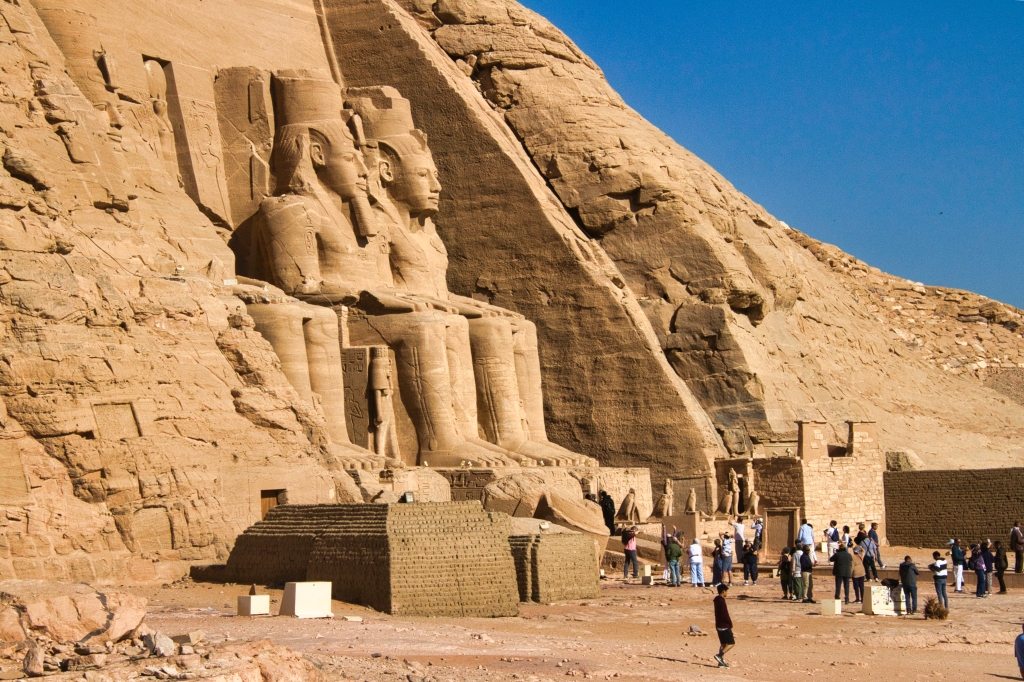
Photo by Galen C. Dalrymple, copyright 2024. All Rights Reserved.
One of the classic places to visit in Egypt, and one of the most impressive, is Abu Simbel. It’s amazing to think that this magnificent structure was almost lost to civilization forever.
When the new Aswan Dam was being constructed, a huge lake (Lake Nasser) was formed. Abu Simbel was located on the side of a mountain and as the waters rose, it became clear that it would be submerged and ultimately destroyed. But the hard thing about it was that it wasn’t a building per se, but it was carved into the solid rock of the mountain. How, if possible, could it be saved?
Several plans were proffered on how to save it, including one plan to built a different dam around the site and turn in into an underwater monument. Fortunately, that plan was rejected and a more ambitious plan was adopted.
Under the direction of UNESCO, a $40 million project was undertaken to literally cut the gigantic statues and temples (there’s one for Ramesses II and his favorite wife, Nefertai) out of the rock and move them to higher ground, where it was reassembed and sits today.
Today’s photo was one of the first glimpses of the temple for Ramesses II that I got. You walk around a corner and – bam! – there it is. The two statues in this image are each 66 feet high and are part of four which originally were at the entrance. Considered to be one of the most beautiful of the Egyptian temples, it is a spectacle both inside and outside and I certainly enjoyed it, though it was very crowded inside the temples themselves – and it was hot as it is at the southern end of Egypt.
At the very back of the temple is a room containing four statues. If memory serves, 3 of them are of Ramesses and one is of the god, Ptah. Two days a year, light flooded down into this most sacred room and illuminated three of the four statues, with only Ptah, the god connected with the realm of the dead which would always remain in the dark even when the other three statues were lit by the sun.
ON THIS DAY IN HISTORY: in 1804, two months before Lewis and Clark began their western expedition, Jim Bridger is born in Richmond, Virginia. Twenty years later, Bridger, heading West along the routes Lewis and Clark pioneered, became one of the greatest mountain men of the 19th century.
The son of a surveyor and an innkeeper, Bridger moved with his family to St. Louis in 1818. There, Bridger apprenticed to a blacksmith, learned to handle boats, and became a good shot and skilled woodsman. When the Ashley-Henry fur trading company advertised for “enterprising young men” to travel the Missouri River to trade with the local tribes, Bridger was among the first to respond, and he was hired in 1822.
Though he lacked much formal education, Bridger demonstrated a brilliant ability for finding his way and surviving in the wilderness. As part of the Ashley-Henry team, he helped construct the first fur trading post on the Yellowstone River. At the age of 21, Bridger became the first Anglo definitely known to have seen the Great Salt Lake, though he mistakenly thought it was the Pacific Ocean at the time. He was adept at learning Indigenous dialects and culture, and he had a tremendous memory for geographical detail.
For several years Bridger worked as an independent trapper and in 1830 he joined with three partners to gain control of the Rocky Mountain Fur Company. Bridger never really enjoyed the life of the businessman, though, and he sold out in 1834. That same year, he married Cora, the daughter of a Flathead chief, and she accompanied him on his fur trapping expeditions. Yet by 1840, Bridger had grown tired of the nomadic trapper life. He was convinced that the emigrant traffic through the West had become heavy enough to support a trading post. He founded Fort Bridger along the Green River section of the Oregon Trail, in present-day southern Wyoming.
Fort Bridger quickly became a regular stopping place for overland emigrants, and Bridger happily settled down with Cora, with whom he had three children. Bridger’s idyllic life did not last, though. Cora died, Native Americans killed one of his daughters, and a second wife died in childbirth. Bridger retreated to the mountains to trap and hunt after each of these tragedies. In 1850, he married the daughter of a Shoshoni chief, and thereafter he and his bride—whom he called Mary—divided their time between summers at Fort Bridger and winters with the Shoshoni.
In 1853, members of the LDS church, resenting the competition from Bridger’s fort, tried to arrest him as an outlaw. He escaped into the mountains with Mary and his children, but a band of Latter-day Saints burnt and gutted the fort, destroying all his supplies. Concerned for his family’s safety, Bridger bought a farm near Westport, Missouri, where he left Mary and the children during all of his subsequent western journeys. He sold Fort Bridger in 1858, and spent the next decade working as a guide and an army scout in the early Indian wars.
By 1868, Bridger’s eyesight was failing, and he increasingly suffered from rheumatism. He retired to his Westport farm, where he cared for his apple trees. He died at the age of 77 on July 17, 1881. – The History Channel
TRIVIA FOR TODAY: Pill bugs, or “rollie pollies,” might look like a bug, but they are a type of crustacean. They’re one of the few crustaceans that live entirely on land. Their relatives include shrimp, crabs, and lobsters.